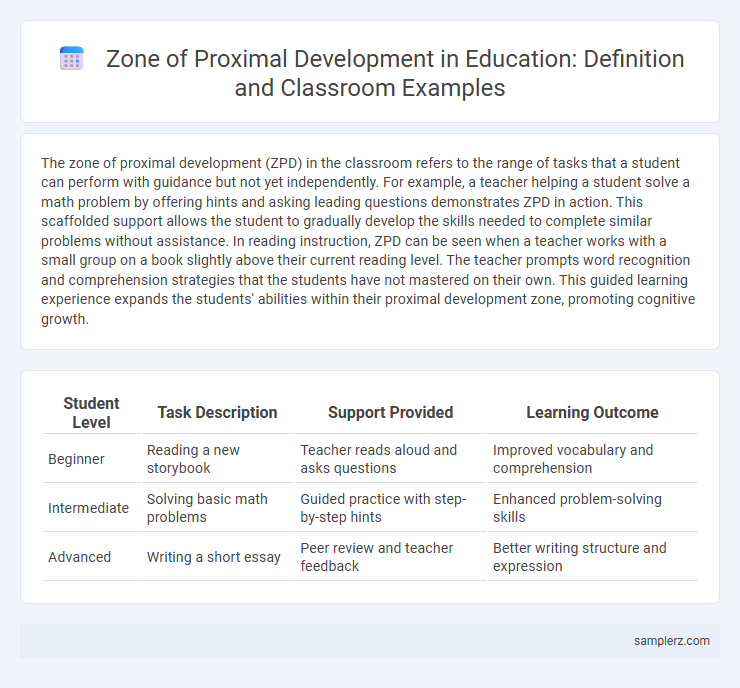The zone of proximal development (ZPD) in the classroom refers to the range of tasks that a student can perform with guidance but not yet independently. For example, a teacher helping a student solve a math problem by offering hints and asking leading questions demonstrates ZPD in action. This scaffolded support allows the student to gradually develop the skills needed to complete similar problems without assistance. In reading instruction, ZPD can be seen when a teacher works with a small group on a book slightly above their current reading level. The teacher prompts word recognition and comprehension strategies that the students have not mastered on their own. This guided learning experience expands the students' abilities within their proximal development zone, promoting cognitive growth.
Table of Comparison
| Student Level | Task Description | Support Provided | Learning Outcome |
|---|---|---|---|
| Beginner | Reading a new storybook | Teacher reads aloud and asks questions | Improved vocabulary and comprehension |
| Intermediate | Solving basic math problems | Guided practice with step-by-step hints | Enhanced problem-solving skills |
| Advanced | Writing a short essay | Peer review and teacher feedback | Better writing structure and expression |
Understanding the Zone of Proximal Development in Education
The Zone of Proximal Development (ZPD) in education is demonstrated when a teacher scaffolds learning tasks to challenge students just beyond their current abilities, such as guiding a student through solving complex math problems they cannot complete independently. Through collaborative interaction and targeted support within the ZPD, learners develop critical thinking skills and gradually gain autonomy. This approach enhances cognitive development by aligning instructional strategies with each student's evolving potential.
Key Features of the Zone of Proximal Development in the Classroom
The Zone of Proximal Development (ZPD) in the classroom is exemplified when a teacher guides students through challenging tasks they cannot complete independently but achieve successfully with support, such as scaffolded reading comprehension exercises. Key features include the use of tailored prompts, interactive dialogue, and timely feedback to bridge the gap between current ability and potential development. This dynamic interaction fosters cognitive growth by maximizing learning potential within the student's proximal learning zone.
Teacher-Student Interactions Illustrating ZPD
A teacher scaffolds a math problem by providing hints and guiding questions, enabling the student to solve tasks just beyond their independent ability, demonstrating the Zone of Proximal Development (ZPD). Through targeted questioning, the teacher effectively bridges the gap between what the student can do alone and what they can achieve with support. This dynamic interaction fosters cognitive growth by gradually transferring responsibility to the learner within their optimal developmental zone.
Collaborative Learning as a ZPD Strategy
Collaborative learning exemplifies the Zone of Proximal Development (ZPD) by enabling students to solve problems with peer support that they cannot achieve independently, thereby extending their cognitive abilities. In classroom settings, group tasks encourage active dialogue and scaffolding, allowing learners to internalize new skills through shared knowledge. This strategy promotes deeper understanding and skill acquisition by leveraging social interaction within students' proximal learning zones.
Scaffolding Techniques Within the Zone of Proximal Development
Scaffolding techniques within the Zone of Proximal Development (ZPD) include guided questioning, modeling, and providing hints to support student learning just beyond their current capabilities. Teachers tailor assistance based on student responses, gradually reducing support as competence increases, fostering independent problem-solving skills. Effective scaffolding in the ZPD promotes deeper understanding and skill acquisition through targeted, interactive instructional strategies.
ZPD Examples in Early Childhood Education
In early childhood education, a classic example of the zone of proximal development (ZPD) occurs when a teacher guides a child through completing a puzzle that they cannot solve independently but can accomplish with support. Through scaffolded interactions, such as asking leading questions and offering hints, educators help children progress from assisted problem-solving to independent mastery. This targeted support within the ZPD fosters cognitive development and enhances learning efficiency in preschool settings.
Differentiated Instruction and the Zone of Proximal Development
Differentiated instruction tailors learning experiences to students' individual zones of proximal development (ZPD), enabling optimal cognitive growth through targeted scaffolding. Teachers assess each student's current abilities and provide tasks just beyond their independent performance level, promoting gradual mastery with guided support. This strategic alignment enhances engagement and accelerates skill acquisition within the learner's ZPD framework.
Peer Tutoring: Harnessing the ZPD in Collaborative Settings
Peer tutoring effectively harnesses the zone of proximal development (ZPD) by enabling students to support each other's learning within their current capabilities and just beyond. Collaborative interactions during peer tutoring facilitate scaffolding, where more knowledgeable peers guide learners through tasks they cannot complete independently. This dynamic promotes skill acquisition and cognitive growth by providing targeted assistance in a social learning environment.
Assessing Learning Growth Using ZPD Principles
Teachers assess learning growth by identifying tasks students can perform with guided assistance, revealing their Zone of Proximal Development (ZPD). Analyzing how students respond to scaffolded support during collaborative activities provides insights into their potential development areas. Ongoing evaluation of these scaffolded interactions helps tailor instruction to maximize educational progress within each learner's ZPD.
Practical Classroom Activities Demonstrating the ZPD
Practical classroom activities that demonstrate the Zone of Proximal Development (ZPD) include guided group projects where students collaborate with peers and receive scaffolding from teachers to complete tasks just beyond their independent capabilities. Interactive role-playing exercises encourage learners to practice new skills with support, gradually reducing assistance as competence grows. These strategies align instruction with students' emerging abilities, fostering effective cognitive development within their proximal learning zones.

example of zone of proximal development in classroom Infographic
 samplerz.com
samplerz.com